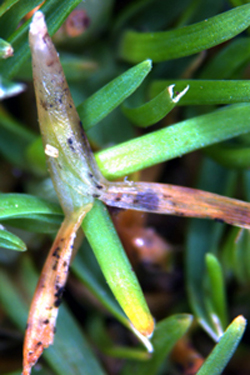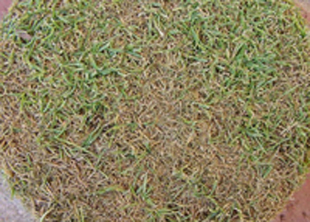G1918
Anthracnose of Turfgrass
Anthracnose is a fungal turf disease most often found on bluegrass or bentgrass. This NebGuide describes the disease and how to best manage it.
Loren J. Giesler, Extension Plant Pathologist
- Introduction
- Cause, Hosts, and Occurrence
- Key Symptoms
- Cultural/Maintenance Practices
- Fungicide Program
Introduction
Anthracnose is a turf disease found most often on intensely managed annual bluegrass or bentgrass. At least 13 warm and cool season grasses are known to be hosts for this disease. Environmental stresses such as drought and heat make the turf more susceptible during the mid-summer months. Both cultural practices and fungicide treatment can help to mitigate this disease. The following describes the disease and how to identify and manage it.
Cause, Hosts, and Occurrence
Cause: Colletotrichum cereale (formerly Colletotrichum graminicola)
Primary Hosts: Annual bluegrass, Creeping bentgrass; most warm and cool season grasses can be a host.
Occurrence: July-August
Key Symptoms
- Irregularly shaped patches of yellow-bronze turf. May also have a reddish cast in the area (Figure 1).
- Elongated, reddish-brown spots on the leaves (Figure 2).
- Infection of the lower stem of shoots (basal rot) can result in the death of tillers and browning of lower leaves.
- Black, spiny fungal fruiting structures (acervuli) on infected leaves, visible with a 10X hand lens.
|
 |
|||
Figure 2. Fruiting structures of the anthracnose fungus (setae of the acervuli), which are visible with a 10X hand lens.* *Figure 2 reproduced with permission from D. Settle, A. Martinez-Espinoza, L. Burpee. 2006. Anthracnose of Turfgrass. The Plant Health Instructor. OI:10.1094/PHI-I-2006-1205-01) Photographer, J. Kaminski. |
Cultural/Maintenance Practices
- Provide sufficient nitrogen to maintain a moderate growth rate through the summer.
- Irrigate to maintain plant vigor and avoid drought stress.
- Compaction and thatch should be managed to reduce stresses.
Fungicide Program
Fungicides for anthracnose management are listed in Table I. Preventive spray programs have typically been more effective than curative programs for this disease. Product examples are provided for each active ingredient, but not all products are listed. Homeowner and commercial product labels will provide a list of active ingredients.
While the active ingredient may be in combination with others, users should look for a specific active ingredient with or without other chemistry modes of action.
Fungicides listed represent the best information available. Read and follow all product label directions for mixing and application.
| Table I. Fungicides for Anthracnose Control in Turf1 | ||||
| Fungicide | Fungicide Class | Interval (days) |
Efficacy3 |
Product Names |
| Azoxystrobin | Strobilurin | 14-28 |
3 |
Heritage® |
| Chlorothalonil | Chloronitrile | 7-14 |
3 |
Daconil Ultrex®3 |
| Fenarimol | DMI4 | 30 |
2 |
Rubigan® |
| Fludioxonil | Phenylpyrrole | 14 |
2+ |
Medallion® |
| Fluoxastrobin | Strobilurin | 14-28 |
3 |
Disarm® |
| Hydrogen dioxide | 7 |
L |
ZeroTol® | |
| Metconazole | DMI | 14-21 |
3 |
Tourney® |
| Mineral oil | Not Classified | 7-21 |
2+ |
Civitas™ |
| Myclobutanil | DMI | 14-21 |
2 |
Eagle® |
| Phosphite | Salts of phosphorus acid | 14 |
2-35 |
Alude™ |
| Polyoxin D | Polyoxin | 7-14 |
3 |
Endorse® |
| Propiconazole | DMI | 14-28 |
2 |
Banner® Maxx® |
| Pyraclostrobin | Strobilurin | 14-28 |
3 |
Insignia® |
| Thiophanate-methyl | MBC4 | 10-14 |
2 |
Cleary’s 3336®3 |
| Triadimefon | DMI | 14-45 |
1+ |
Bayleton®3 |
| Trifloxystrobin | Strobilurin | 14-21 |
3+ |
Compass® |
| Triticonazole | DMI | 14-28 |
3 |
Trinity®3 |
| 1Fungicide active ingredients, class, and efficacy ratings for products labeled for the control of anthracnose. Table adapted from P. Vincelli and D.W. Williams, Chemical Control of Turfgrass Diseases 2011, University of Kentucky Cooperative Extension Service.
2Rating system: 4 = consistently good control; 3 = good to excellent control; 2 = fair to good control; 1 = control is inconsistent but performs well in some instances; L = limited published data on effectiveness; + = intermediate between two efficacy categories. 3Other products with the same active ingredient may be available. 4DMI fungicides are demethylation inhibitors and are otherwise known as Triazole fungicides. MBC = Methyl Benzimidazole Carbamate. 5More effective for controlling anthracnose on Poa annua than on creeping bentgrass. |
||||
This publication has been peer reviewed.
Disclaimer Reference to commercial products or trade names is made with the understanding that no discrimination is intended of those not mentioned and no endorsement by University of Nebraska–Lincoln Extension is implied for those mentioned. |
Visit the University of Nebraska–Lincoln Extension Publications website for more publications.
Index: Plant Diseases
Turf
Issued July 2011
